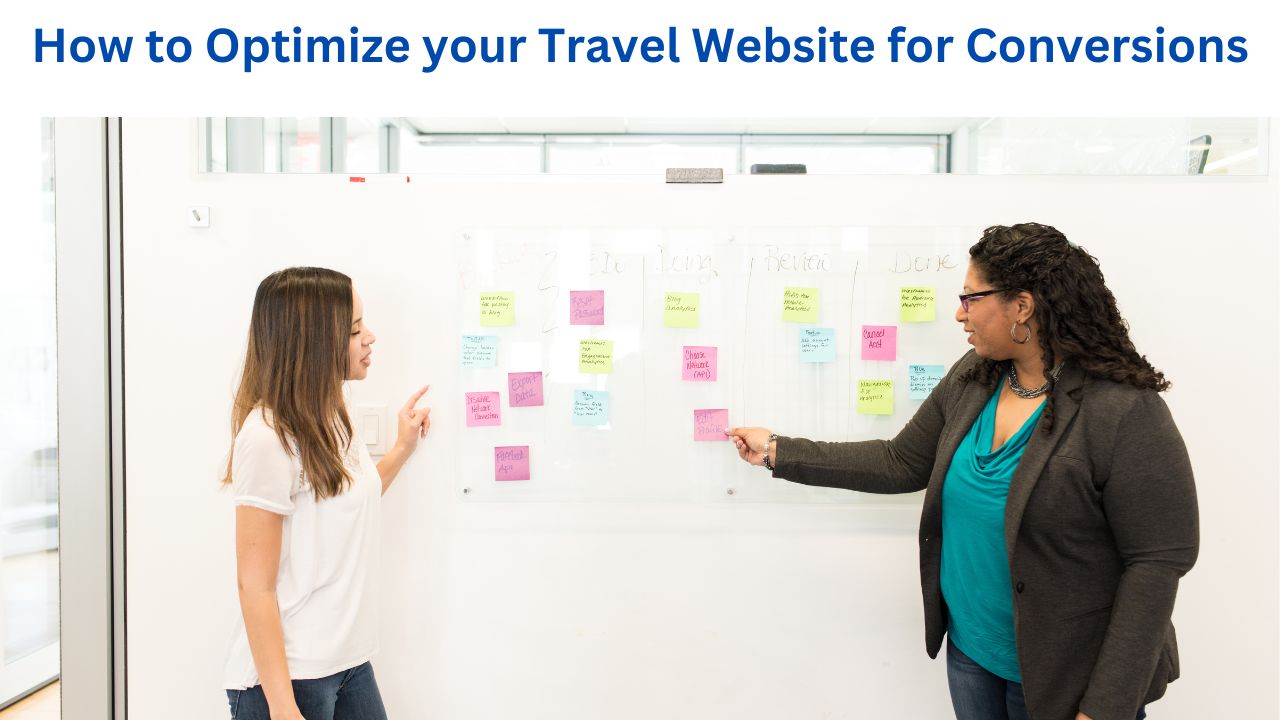
How to Optimize your Travel Website for Conversions
Just like any other travel industry, the competition level is high, and the design of the website would do all the magic in capturing leads and converting them to loyal customers. Unlike great design, optimization of travel websites for conversions involves strategic planning, understanding user behavior and providing the right incentives at the right time.
This will be an all-encompassing guide to the ways you can optimize your travel website so users get a better experience, come back to visit, and most importantly, convert.
1. Understanding Website Conversions
Before we dive into optimization techniques, let's define what a "conversion" means for your travel website. "Conversion" is defined in many ways by your business goals:
Travel or Flight Booker:
Inquiry or Lead Generation from filling out your contact form to learn more.
Newsletter Subscribers who sign up for updates or special offers.
App downloads: when you have a mobile application, increasing its downloads.
Account creation: when users sign up to your account in order to get more personalized services.
Each of these conversion types is essential on their own within your overall sales funnel and helping your site improve can give you so much better opportunities at turning occasional visitors into paying customers.
2. Make a User Friendly Design in the Web Site:
A website that converts should be user-friendly and easy to navigate. This is the core foundation to higher conversion rates. Tips to improve it:
a) Responsive Design
With more people currently making bookings on mobile devices, one needs to have a mobile-friendly website. Ensure that your website is responsive-that is, it changes its layout with different screen sizes and equally ensures consistency of experience across desktops, tablets, and smartphones. Furthermore, Google ranks websites that are mobile-friendly higher, meaning increasing visibility.
b) Intuitive Navigation
Your website should be simple to navigate with clearly descriptive headings and categories. There should not be a million options to bewilder the visitor. Use a logical hierarchy of categories like this:
-
Flights
-
Hotels
-
Tour Packages
-
Car Rentals
-
Travel Guides
Use drop-down menus to keep your navigation clean, and allow the users to easily go back to the main homepage or category pages.
d) Cleaning up of Call-to-Action (CTA) buttons
It is in the CTAs that users learn how to move through the conversion funnel. Make sure that your CTAs have the following characteristics:
CLEAR Utterly said, your calls to action must contain the likes of "Book Now," "Get a Quote," or "Sign Up Today.".
Clearly: Display them on a prominent feature of the webpage, such as at the top of the home page, or next to travel deals.
Compelling: Use value or urgency, like "Limited-time offer," or "Exclusive deals.
3. SEO Optimization
A travel website can be optimized for better search engine rankings, and hence, a more significant chance of organic traffic, as well as conversion. The main strategies of travel SEO include:
a) Targeted keywords
Keyword research is more or less the question of what your potential customers will be searching for. For example, you could use keyword research tools such as Google Keyword Planner or SEMrush to give the search volume and show relatively little competition. For example:
-
Aspect travel packages to [Destination]
-
Cheapest flights to [Destination]
-
Best hotels in [City]
These words should be used organically and spread throughout your page title, headings, meta descriptions and body copy in order to boost the likelihood of the search rankings.
b) Local SEO
If you are a travel business operating in specific areas only, then local SEO is very important. But let your website be optimized for the local search by:
List your business on Google My Business for better visibility in the Google Maps and search results in the local area.
Using local phrases; for instance, "Best travel agency in [City]."
c) Content Marketing
Write quality content in the form of travel blogs, guides, or itineraries. This will give you the benefits of link generation and dwell time of being on your site aside from adding value for the visitor. Use keywords naturally but always mindful to offer useful and interesting information.
4. Deepen Personalization and AI tools
Personalization becomes extremely indispensable for travel in the near future. With personalization, one can spike the levels of user engagement and conversion rates with customized experiences.
Dynamic Content
The other area you can work with regards to dynamic content is targeting users based on certain behavior, preferences, or demographics. For instance, you may want to offer unique deals or travel packages to first-time visitors and different ones to returning users. You would use the tools available in Optimizely or Google Optimize to set up a dynamic content that changes with every interaction between the user.
b) AI-Driven Recommendations
Integrate AI-based technologies, such as chatbots or recommendation engines, for increased user engagement.
Examples:
Chatbots:
Provide a user with information about the in-flight status of their booking.
Recommend package offers, booking of a particular type of seat, or meal services.
Personalized travel packages:
Customized travel packages; deploy algorithms that suggest travel packages based on a user's browsing history, location, and preferences.
c) Behavioral Triggers
Behavioral triggers allow a business to make pertinent messages at the right time to a person. For instance, if the visitor abandons halfway booking, you can have a popup to start with a discount coupon or afterwards with an e-mail copy as customization or personal reminder.
Also Read:- How You Can Build Your Travel Management Team
5. Create Trust through Social Proof and Reviews
A major component of the travel industry is trust, because people are spending huge amounts for something they dearly hope to meet their wants. Having social proof on your website can reassure visitors and make you more reliable.
a) Customers' Reviews
Use user reviews and testimonials on your package pages. Use a mix of high and useful feedback so as not to appear quite perfect.
This is also a good time to include platforms like Trustpilot or Google Reviews to show ratings directly on your site.
b) User Generated Content
Get former customers telling stories of their experiences while on travel and sharing pictures of the same on your website or social media. UGC introduces a sense of community and trust to the site as prospective customers view real experiences from people like them.
c) Awards and Recognition
Highlight awards and recognitions from travel associations for winning the travel company of the year or best travel company of the year. Badges like "Top-Rated Tour Operator" or "Certified Travel Partner" add so much more credibility, and they have a very high conversion rate.
6. A Powerful Booking Engine and Gateway
Your booking engine is the central business component of your travel website functionality. The moment bookings are complicated, you are more likely to lose potential customers at that most critical stage of conversion. Here's how to optimize it:
a) Easy and Intuitive Booking Interface
The booking engine at your end should be easy and intuitive. To achieve that, here are some best practices on how to get there:
Few Steps: The total steps toward booking must be fewer, ideally three or fewer.
Clear Progress Indicators: Show the users where they are in their booking process with a progress bar or step indicators.
Guest Checkout: Implement guest checkout, so users can check out without having to register; this will cut down friction.
b) Secure and Wide Acceptance of Different Payment Gateways
The first thing that sits at the top of all online transactions is security. So ensure your gateway is secured with SSL encryption along with PCI compliance on how to handle user data. As an addition to this, allow wide acceptance of the following payment gateways: Credit/Debit Cards, PayPal
Mobile Wallets, including Apple Pay and Google Pay Bank Transfer.
7. Retargeting and Email Campaigns
Not all visitors convert during their first visit. The users can be retriggered to go back to your website through retargeting and email campaigns which will eventually lead them into concluding on booking.
Retargeting Ads
Retargeting ads are displayed as personal ads from those users who visited your website and did not convert. You target them using:
-
Special offers or discounts
-
Reminders concerning travel packages they viewed
-
Free upgrades or complimentary services
-
Email Marketing
-
Capture leads via email sign-ups or cart abandonment emails. Use targeted campaigns to send:
-
Targeted promotions of their interests
-
Reminders for incomplete bookings
-
Informative content like travel guide and destination information.
b) Email marketing
It also captures leads from email subscriptions or those abandoned cart emails. Introduce targeted email marketing campaigns to;
Send promotions that are customized based on the interests of the users.
Remind clients whose bookings are yet complete.
Share blog content, especially useful travel-related information or all-inclusive destination guides.
8. Analytics monitoring and strategy adjustment
To ensure that what you are doing for optimization is actually working, it is also essential to monitor your website with analytics tools, Google Analytics or Hotjar. Here are some of the key points to measure.
Conversion Rate - The percentage of visitors who take the desired action
Bounce Rate - The percentage of visitors that leave your site after viewing just one page
Exit Pages: This will tell you where the users are dropping off so you can improve those pages
Average Session Duration: Sessions longer than 10 seconds indicate higher engagement
Monitor and measure these metrics over time to determine areas of improvement, and continue adjusting strategies to optimize the travel website even more for the conversion it seeks.
Conclusion
Maximizing travel website conversions is an ongoing improvement process as far as user experience is concerned, leveraging SEO, the personalization of interactions, and a booking process. When you master these core elements and keep refining your strategies, the increase in conversion rates makes it profitable to turn visitors into loyal customers.
Also Read:- Travel Website Backend Essentials

 Start your Travel Business with Our 7 Day Free Trial Website!
Start your Travel Business with Our 7 Day Free Trial Website!





